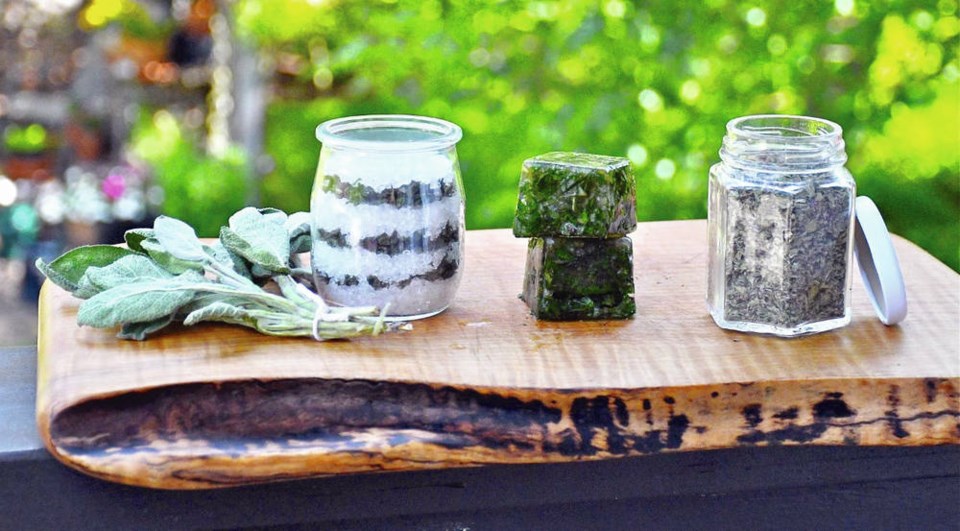If you have an herb garden, or buy fresh herbs, these things are often true: You鈥檒l have leftover herbs after using some for a recipe. Or, you鈥檒l have so many herbs growing in your garden you only use a fraction of them during the growing season.
That, in turn, must explain why readers frequently ask me how to preserve herbs. I鈥檝e not written about that topic for many years, so here鈥檚 a refresher course.
In all methods below, if the herbs you have are clean, there鈥檚, obviously, no need to wash them again before preserving them, as some of there natural oils may be lost during the process. However, if the herbs are dusty or dirty, dip and gently swirl bundles of them in cold water to clean them. Shake off the excess water and then, before using, hang them until dry, or dry on a kitchen towel.
Freezing: Freezing herbs helps to preserve their vibrant colour. One method is to set herb sprigs in a single layer on parchment paper-lined sheet. Now freeze them solid, transfer to a freezer bag or container, and keep frozen. When you want to use some, take out what you need, chop or crumble it, and add to the dish you are making.
You can also chop herbs before freezing them, individually, or in combination with other herbs. Once chopped, set in a bowl, moisten with a bit of stock or olive oil, and then spoon into an ice cube tray and freeze. Once frozen, unmould and place the frozen herb cubes in freezer bags or containers and keep frozen until needed for a soup, stew, salad or other dish.
Oven drying: Preheat oven to 185 F to 200 F. Set herbs sprigs, or leaves of fresh herbs, in a single layer on parchment paper-lined baking sheet. Place in the oven, with oven door held slightly ajar with a kitchen spoon. Gently heat herbs until completely dry, about 25 to 30 minutes or more, depending on the type. Let herbs cool, and then crumble, crush or grind and store in a sealed jar alongside your other dried herbs.
Microwave drying: This method is good for quickly drying herbs. Set a piece of paper towel on a microwave-safe plate. Set a single layer of herbs sprigs or leaves on the paper towel. Set another piece of paper towel on top of the herbs. Microwave herbs on high one minute. Check herbs and if not completely dry, continue heating in 20-second intervals, until they are. During the process, watch the herbs closely, as you don鈥檛 to scorch them. Let herbs cool, and then crumble, crush or grind and store in a sealed jar alongside your other dried herbs.
Hang drying: Gather herbs into bundles and tie stems together. Place each bundle into a brown paper lunch bag with the stems extending out of the open end. Poke some small holes in each bag for ventilation. Tie and hang the bags, stems side up, in a dark, dry, room-temperature or slightly warmer place. After one or two weeks or more, when the herbs are completely, take them out of the bags. Now remove the leaves from the stems, crumble, crush or grind them, and store in a sealed jar alongside your other dried herbs. Or simply pack the dried herbs, while still on the stem, in tight-sealing bags and remove and process the leaves from them just before needed.
Food dehydrator: If you have a food dehydrator, or were thinking of buying one, it too, of course, can be used to dry herbs. Read the machine manual for directions.
Salting: In a sterilized, dry, 125 or 250 millilitre jar, layer chopped fresh herbs, such as thyme, sage and rosemary, with coarse sea salt or kosher salt, ensuring the top and bottom layers are salt. Store jar in your pantry. Overtime, the salt will draw moisture from the herbs, preserving them. Use this herb-flavoured salt to season steaks and roasts.
Eric Akis is the author of eight cookbooks. His columns appear in the Life section Wednesday and Sunday.



